Brownfield redevelopment project revives a central neighbourhood
Working with a visionary developer, the Region of Waterloo and the City of Kitchener helped transform an industrial brownfield site in Kitchener's downtown into showcase offices, attracting tenants such as Google and reviving a central neighbourhood.
Read the case study below to learn about project highlights, as well as the challenges and lessons learned that can help your community in planning similar projects.

About the project
| Municipal population | Project duration | Total project value |
|---|---|---|
| 569,000 | 2009–2015 |
|
The Region of Waterloo and the City of Kitchener, ON, worked closely with the Perimeter Development Corporation to turn an abandoned industrial block near its downtown into a technology-oriented office space. The project is bringing new jobs and life to a central neighbourhood.
The Breithaupt Block is located in Kitchener's city core close to a planned transit hub. The site, vacant since 2007, had century-old buildings with great renovation potential. However, both soil and groundwater on the site were contaminated with industrial pollutants including hydrocarbons, zinc and benzene. Perimeter bought the block in 2009, planning to transform it into high-quality office space. The city and region supported the development with grants to help cover environmental assessment and site remediation costs.
The development includes beautifully renovated historic brick and beam buildings and an energy- and water-efficient LEED® Gold addition. The project, which has attracted tech-focused tenants including Google, is generating job opportunities downtown and sparking new growth in the surrounding neighbourhood.
|


Results
| Environmental | Economic | Social |
|---|---|---|
|
|
|
Challenges
- The Breithaupt Block needed a developer with vision. It was a challenging industrial site with vacant buildings and ponds of process water, but its location in a central neighbourhood and adjacent to a planned transit hub meant it could be pivotal for the city's redevelopment.
- The first hurdle for the project was getting rid of heavy industrial machinery left on site by the previous owner. The developer found a recycling company that cleared the site in exchange for the value of the recycled material.
- Coordinating the Breithaupt development with the region's light rail transit plans has been demanding, involving regular contact with representatives from Kitchener's planning department, two Region of Waterloo departments and the consortium building the transit system.
Lessons learned
- Designate a single contact person from the municipality and ensure that there is regular communication between the developer and municipal staff.
- Try to develop realistic expectations and timelines; brownfield redevelopment almost always takes more time and more money than you expect.
- Be patient. Remediation takes time. Redevelopment takes time and reimbursing eligible expenses takes time.
- Share your vision with the developer and try to ensure that all parties have the same understanding. Sharing a vision and philosophy for brownfield redevelopment goes a long way toward building trust and collaboration on a project.
- Offer tax incentives for brownfield projects. Developers are more likely to tackle site remediation if they can recover a portion of the costs. It may also help them to negotiate project financing.
More information
Peter Ellis, Planning, Development and Legislative Services
Region of Waterloo, Ontario
T. 519-575-4500 ext. 3112
Want to explore all GMF-funded projects? Check out the Projects Database for a complete overview of funded projects and get inspired by municipalities of all sizes, across Canada.

